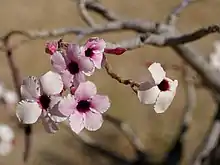Adenium boehmianum
Adenium boehmianum, the Bushman poison, is a poisonous succulent endemic to the mostly dry regions of northern Namibia and southern Angola.[1] The San people boil the root sap and latex to prepare arrow poison, which is sufficient for hunting large mammals, as it contains strong cardiotoxic effects.[1] The leaves, borne only for three months a year, are arranged spirally and are clustered near the branch tips. A plant will flower for only a few weeks in winter.[1] The oblong fruit releases many seeds through a longitudinal slit, which due to their lateral tufts, can be dispersed by wind.
| Adenium boehmianum | |
|---|---|
 | |
| In flower near the Cunene River, Namibia | |
| Scientific classification | |
| Kingdom: | Plantae |
| Clade: | Tracheophytes |
| Clade: | Angiosperms |
| Clade: | Eudicots |
| Clade: | Asterids |
| Order: | Gentianales |
| Family: | Apocynaceae |
| Genus: | Adenium |
| Species: | A. boehmianum |
| Binomial name | |
| Adenium boehmianum | |
See also
References
- Schmelzer, G.H., Gurib-Fakim, A. (2008). Plant Resources of Tropical Africa 11(1), Medicinal plants 1. Wageningen, Netherlands: Prota Foundation, Backhuys Publishers, CTA. pp. 43–45. ISBN 978-90-5782-204-9.
{{cite book}}: CS1 maint: multiple names: authors list (link)
This article is issued from Wikipedia. The text is licensed under Creative Commons - Attribution - Sharealike. Additional terms may apply for the media files.